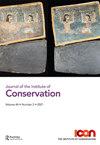“世界艺术爱好者联合起来援助佛罗伦萨”:灾后遗产众筹中激励人群的技巧
IF 1
0 HUMANITIES, MULTIDISCIPLINARY
引用次数: 0
摘要
众筹很大程度上依赖于公众的参与,而公众的参与是有一定条件的,比如参与的动机、参与号召的有效性等。以1966年佛罗伦萨洪水为例,本文探讨了1966年至1968年期间在美国成立的“拯救意大利艺术委员会”(Committee to Rescue italy Art)所采用的激励人群的技术,该委员会旨在帮助保护佛罗伦萨的遗产。在新闻报道和CRIA的呼吁中,七个重叠的框架很明显:损害、筹款、人员、救援、修复、委员会及其行动,以及佛罗伦萨的价值。从本质上讲,激励人们参与灾后众筹的技术包括:(1)对主流媒体的依赖;(2)频繁使用所有可用的通信渠道;(3)多种类型的支持电话;(4)重视佛罗伦萨的价值;(5)强调共同的主人翁意识;(六)具有紧迫感;(7)唤起对过去灾难的记忆。新闻媒体致力于告知公众,而CRIA则致力于鼓励公众参与。分析的媒体报道并没有利用情感内容来吸引人群参与,而CRIA发起的呼吁使用了一些情感内容。文章最后讨论了管理众筹活动的意义,以利用分散的集体行动的力量。本文章由计算机程序翻译,如有差异,请以英文原文为准。
‘Art lovers of the world unite to aid Florence’: techniques to motivate the crowd in post-disaster heritage crowdfunding
Crowdfunding relies heavily on public participation and public participation is subject to certain conditions, such as the motivation to participate and the effectiveness of the call to participate. Using the case of the 1966 Florence Flood, this article explores the techniques to motivate the crowd adopted by the Committee to Rescue Italian Art, a committee formed in the USA to help protect the heritage of Florence, and newspaper reports published in the USA between 1966 and 1968. Seven overlapping frames were evident in the news reports and the CRIA’s call: damage, fundraising, people, rescue, restoration, the committee and its actions, and the value of Florence. In essence, the techniques adopted to motivate people to participate in the post-disaster crowdfunding included: (1) the dependency on mainstream media; (2) frequent use of all available communication channels; (3) multiple types of calls for support; (4) emphasis on the value of Florence; (5) highlighting a shared sense of ownership; (6) giving a sense of urgency; and (7) evoking the memory of past disasters. While the news media worked to inform the public, CRIA worked to encourage them to participate. The media reports analysed did not leverage emotive content to attract crowd participation whereas the calls initiated by CRIA used some emotive content. The article concludes with a discussion on the implications for managing crowdfunding campaigns to utilise the power of decentralised collective action.
求助全文
通过发布文献求助,成功后即可免费获取论文全文。
去求助
来源期刊

Journal of the Institute of Conservation
HUMANITIES, MULTIDISCIPLINARY-
CiteScore
1.50
自引率
0.00%
发文量
22
期刊介绍:
The Journal of the Institute of Conservation is the peer reviewed publication of the Institute of Conservation (Icon). As such, its aims reflect those of Icon, to advance knowledge and education in conservation and achieve the long term preservation and conservation of moveable and immoveable cultural heritage. The Journal provides a collective identity for conservators; it promotes and supports both the profession and professionalism. With international contributions on all aspects of conservation, it is an invaluable resource for the heritage sector. The specific aims of the Journal are to: 1. promote research, knowledge and understanding of cultural heritage conservation through its history, practice and theory 2. provide an international forum to enable and disseminate advances in research, knowledge and understanding relating to conservation and heritage 3. champion and support professional standards of heritage conservation in the UK and internationally 4. provide a permanent record of issues relating to conservation and heritage 5. be financially and operationally sustainable. To achieve these aims, the Journal invites contributions from all those involved in the conservation of cultural heritage and related activities. Areas of interest include understanding cultural heritage materials and their degradation; subject reviews and histories of cultural heritage materials and conservation treatments; new, innovative or improved approaches to conservation and collections care theory, practice, communication, management and training; case studies demonstrating new, innovative or improved approaches; and conservation in its wider context. Submitters are encouraged to demonstrate how their work is of practical application to conservation. To maintain professional standards and promote academic rigour, submissions of articles and shorter notices are subject to an anonymous peer review process.
 求助内容:
求助内容: 应助结果提醒方式:
应助结果提醒方式:


